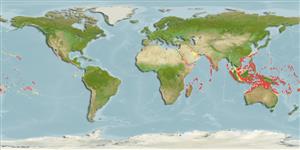Teleostei (teleosts) >
Eupercaria/misc (Various families in series Eupercaria) >
Labridae (Wrasses) > Cheilininae
Etymology: Pteragogus: Greek, pteron = wing, fin + Greek, ago = to drive (Ref. 45335).
More on author: Randall.
Environment: milieu / climate zone / depth range / distribution range
Ecology
Marine; reef-associated; depth range 2 - 67 m (Ref. 1602). Tropical; 30°N - 24°S
Indo-West Pacific: Red Sea; then from Indonesia to Samoa, north to the Philippines and Micronesia, south to the Great Barrier Reef.
Length at first maturity / Size / Weight / Age
Maturity: Lm ?, range 4 - ? cm
Max length : 9.5 cm TL male/unsexed; (Ref. 2334)
Dorsal spines (total): 10; Dorsal soft rays (total): 10; Anal spines: 3; Anal soft rays: 9. Has 10 dorsal spines, lacks distinct vertical barring or longitudinal lines, and has yellow or reddish edged ocellus on the gill cover. First 3 dorsal fin spines elongated in adults (Ref. 48636).
A secretive species occurring on coral reefs where it hides among soft corals and benthic algae. Feeds on benthic invertebrates. Monogamous (Ref. 52884). Rarely found in the aquarium trade (Ref. 2334). Population from Western Indian Ocean and Red Sea may be different species from fishes from the Pacific; genetic studies are needed (Ref. 90102).
Life cycle and mating behavior
Maturity | Reproduction | Spawning | Eggs | Fecundity | Larvae
Oviparous, distinct pairing during breeding (Ref. 205).
Randall, J.E., G.R. Allen and R.C. Steene, 1990. Fishes of the Great Barrier Reef and Coral Sea. University of Hawaii Press, Honolulu, Hawaii. 506 p. (Ref. 2334)
IUCN Red List Status (Ref. 130435: Version 2024-1)
Threat to humans
Harmless
Human uses
Fisheries: of no interest; aquarium: commercial
Tools
Special reports
Download XML
Internet sources
Estimates based on models
Preferred temperature (Ref.
123201): 26 - 29, mean 28 °C (based on 790 cells).
Phylogenetic diversity index (Ref.
82804): PD
50 = 0.5010 [Uniqueness, from 0.5 = low to 2.0 = high].
Bayesian length-weight: a=0.01585 (0.00700 - 0.03587), b=2.95 (2.76 - 3.14), in cm total length, based on LWR estimates for this (Sub)family-body shape (Ref.
93245).
Trophic level (Ref.
69278): 3.5 ±0.37 se; based on food items.
Resilience (Ref.
120179): High, minimum population doubling time less than 15 months (Preliminary K or Fecundity.).
Fishing Vulnerability (Ref.
59153): Low vulnerability (10 of 100).
Nutrients (Ref.
124155): Calcium = 114 [67, 207] mg/100g; Iron = 0.846 [0.487, 1.587] mg/100g; Protein = 18.3 [15.5, 20.6] %; Omega3 = 0.184 [0.111, 0.301] g/100g; Selenium = 27 [15, 49] μg/100g; VitaminA = 159 [48, 623] μg/100g; Zinc = 1.97 [1.31, 3.10] mg/100g (wet weight);
